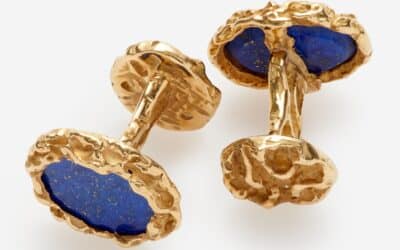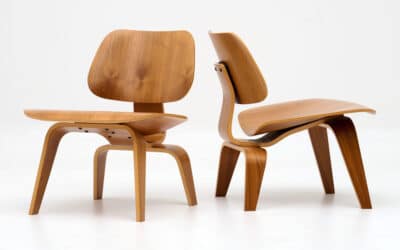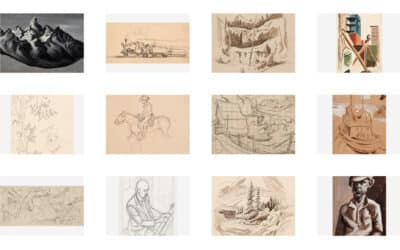
The History of Lalique Glass
Lalique, The Jeweler |Lalique, The Glassmaker | Authentication & Value
By Circle Auction | July 2018
Lalique is a prominent name to art glass connoisseurs. Best known for intricate nature-inspired glass designs, the luxury brand was founded over 130 years ago in Paris by visionary craftsman, René Lalique (1860-1945).
Lalique, The Jeweler: Apprenticed at age 16 to master goldsmith Louis Aucoc, young René also honed his craft as a jeweler at Ecole des Arts Decoratifs in Paris and the Sydenham School of Art in London. Upon his return to France in 1880, he began a career as a freelance jewelry designer. By 1881, Lalique was designing for prestigious names like Cartier and Boucheron, as well as for private clients. By 1886, he had his own workshop, where he experimented with glass and sculpture in his designs. By 1890, Lalique had launched a jewelry shop in the fashionable Opera district of Paris and was recognized as a rising star in his field.

RENE LALIQUE PINK CARNATION PENDANT BROOCH C. 1901-1902
At the Exposition Universelle of 1900, Lalique’s display caused a sensation. Crowds gathered to see his designs. While René had already found massive success as a designer, this event created international demand for his work. His pieces were broadly recognized as true objets d’art.
Stumbling across authentic René Lalique jewelry that hails from this period is extraordinary luck. Most are treasured by private collectors and are considered museum-worthy. When they do appear at auction, deep pockets prevail. Recent results from Christie’s find these antique Lalique jewels nearly always achieving upwards of $300,000 and often, significantly more. It’s not a surprise. In 1897, Emile Galle, one of the era’s most esteemed glass artists, referred to Lalique as “the inventor of modern jewelry.”

LALIQUE FROSTED RHINOCEROS FIGURES SOLD BY CIRCLE AUCTION
In 1908, Francois Coty commissioned Lalique to design perfume labels and bottles, instantly refashioning an age-old industry. Prior to this time, expensive perfume was stored in plain flasks. As perfume began to be mass produced using synthetic oils, René saw the opportunity for market expansion and began designing hundreds of beautiful bottles for perfumers. With the exception of a few highly sought after designs which are worth multiple thousands of dollars, these collectible bottles now often achieve between $300-$2,500 at auction.
With the bottle business booming, René rented a small factory in Combs-la-Ville (eventually purchasing it in 1913) and became an entirely committed glass manufacturer. Once cast, Lalique pieces were often subjected to many other design touches, including enameling and polishing. The factory eventually employed several hundred people at a time, making not only perfume bottles but a variety of useful and beautiful R.Lalique glass objects. Bowls, plates, glasses, pitchers, decanters, and vases emerged from his studio, along with ashtrays, clocks, decorative objects, frames, mirrors, pendants, light fixtures, fountains, doors, and hood ornaments for cars.
Lalique’s glass hood ornaments or car mascots are sought by both glass and automobile collectors today. Designed to adorn luxury cars of the art deco period, Lalique even fashioned a special base and wiring that could be adjusted to make the mascot glow in several colors while driving! A total of 31 hood ornaments were produced from 1925 through the early 1930s (30 commercially sold models and a single unique design for the Prince of Wales). These bold and elegant statement pieces were based on animals, women, and even St. Christophe (the patron saint of safe travels). Recently a rare Renard (fox) ornament from 1930 achieved GBP 275,000 (over $300,000 US) in a 2017 London auction. Other Lalique car mascots from this era usually achieve anywhere between $1000-50,000 depending on their rarity and condition. Colored and color tinted mascots are higher in value due to relative rarity. Crystal mascots cast from Lalique’s original molds were manufactured at several periods throughout the latter 20th century up to now — current versions are sold as paperweights. These later ornaments are usually valued under $1000.
During WWI, Lalique’s glass factory produced practical items for military hospitals. When the war ended, he began work on a second, larger factory at Wingen-sur-Moder in the Alsace region of France; an area known for its glass making tradition. Lalique glass was now in huge demand, and René expressed the desire to reduce prices so his art glass could be available to a wider audience. Opened in 1921, his new factory, Verrerie d’Alsace glassworks, is still operating today as the sole manufacturer of Lalique glass.
Throughout the 1920s and 30s, René was commissioned for a number of large-scale design projects. He designed doors for Prince Yasuhiko Asaka’s home in Tokyo, created a fountain for the Galerie des Champs-Elysees in Paris, and produced lighting columns and chandeliers for the first class dining room of the luxury ocean liner Normandie.
Sadly, WWII effectively crushed Lalique’s business and very nearly ended his company. As war encroached on the region and the area was evacuated, 79-year-old René rushed to his Wingen factory to try to salvage what he could. He arrived to find his factory closed and soldiers at the gates who told him to return to Paris. Lalique died at his home on May 5, 1945. Just days before his death, he received word that his factory had been liberated by Allied troops and his treasured glass molds were miraculously unscathed.

A LALIQUE QUATRE TÊTES FEMMES ET RAISINS VASE SOLD BY CIRCLE AUCTION
The Cristal Lalique Era: After René’s death, his son Marc Lalique took over the glass making operation. Marc changed production to a heavier lead crystal. The designs from this period were marked M.Lalique and later Cristal Lalique and Lalique France. Marc died in 1977 and passed the business on to his daughter, Marie Claude Lalique. A jewelry designer in her own right, Marie also created her own scents and launched a line of Lalique perfumes in the early 90s. In 1994, Lalique was sold to the French company, Pochet and has since been acquired by the Swiss company, Art & Fragrance.
Since 2008, Art & Fragrance has continued and expanded the Lalique tradition. Lalique still produces beautiful designs, both new and old, out of the modernized 1921 Wingen factory. In recent years, they have manufactured many crystal reproductions of original René Lalique glass art, opened a Lalique museum, and launched a line of luxurious household furniture, decor, and linens.

A LALIQUE QUATRE TÊTES FEMMES ET RAISINS VASE SOLD BY CIRCLE AUCTION
The value of each piece varies widely based on condition, the era it was produced, and the rarity of the design. Colored and tinted Lalique art glass from the early 1900s is the most valuable, but later Lalique crystal is also desired by collectors.
The brand has used several different marks and signatures over the years. During René’s lifetime, most pieces were signed R.Lalique. The label Lalique France always signifies post-WWII production. Unfortunately, forgeries do exist, so it’s important to have your pieces evaluated to know the true value.
If you have a piece of Lalique (or any other type of art glass) that you’re interested in learning it’s value/exploring selling at auction, Circle offers free item evaluations.
More Articles
Jewelry
JEWELRY Fine + Designer + Antique Ended May 3rd Shipping Info Circle Auction is excited to present our yearly dedicated Jewelry auction; composed of fine, designer, antique, and Native American jewelry collections from around the Kansas City area. Designer...
Summer Modern + Contemporary
Contemporary + Modern ART & DESIGN | Aug. 9th - 24thREGISTER FOR THE AUCTION Circle Auction is currently assembling our next event focused on modern design and contemporary art, consigned from various collections in Kansas City and around the region.Current design...
Rare Paul Evans Studio Cabinet At Auction
Unveiling a Masterpiece: Rare Paul Evans Studio Cabinet at Auction By Circle Auction | Jan. 2024 A masterpiece of mid-century modern design is headlining Circle Auction's first Modern + Contemporary auction of 2024. A rare sculpted bronze cabinet by the legendary...
Auction Results from Thomas Hart Benton Collection of Original Works
Auction Results from Thomas Hart Benton Collection of Original Works By Circle Auction | Dec. 2023 Campanella Collection of Benton Works Kansas City's Circle Auction concluded the sale of 113 original Thomas Hart Benton works this past December. The...




